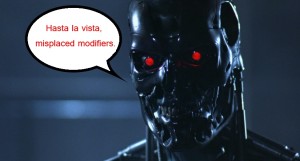Will Robots Replace Editors?
 The new, more globalized international economy means more and more processes are outsourced and automated. We’re growing increasingly accustomed to Bangalore-based telephone customer service agents and cheaply made garments manufactured in foreign factories with dubious health and safety standards. With globalization also comes mobilization; larger and larger varieties of services are available online from desktop computer or mobile devices. These shifts toward a more technologically empowered service sector are often exciting, but some of us in the writing and editing fields are dismayed at and distrustful of the growing prevalence of computer-generated copy and automated editing systems.
The new, more globalized international economy means more and more processes are outsourced and automated. We’re growing increasingly accustomed to Bangalore-based telephone customer service agents and cheaply made garments manufactured in foreign factories with dubious health and safety standards. With globalization also comes mobilization; larger and larger varieties of services are available online from desktop computer or mobile devices. These shifts toward a more technologically empowered service sector are often exciting, but some of us in the writing and editing fields are dismayed at and distrustful of the growing prevalence of computer-generated copy and automated editing systems.
Should we be worried? Well, a quick Google search will demonstrate the inferiority of generic robot-generated copy enriched with SEO keywords designed to boost search results for male enhancement medications or car insurance quotes. For businesses that actually care what potential customers think of their products or services, it looks like human copywriters’ jobs are safe for the foreseeable future.
But what about robot editing services? Could Rosie from “The Jetsons” turn around a perfectly structured, concisely worded article with expert adherence to AP Style? Here are a couple programs that further the theory that editing may be headed the way of the dinosaurs and some thoughts on why a human editor will likely always be the safest bet.
AP StyleGuard
AP StyleGuard is a subscription software service designed to automatically check documents for proper AP structure and punctuation. With a goal of helping users circumvent the need to constantly reference the paper AP Stylebook, this system is regularly updated to ensure it’s always checking for compliance with the latest updates.
But what about style? Despite its name, adhering to AP Style doesn’t mean a writer can use the quick-reference guide to come up with a unique voice – a style. You can’t put an AP “filter” over bad writing and make it good or even adequate. While a tool like this may help overwhelmed writers and editors cut some copyediting corners, we see no reason for real-life editors to worry that this program will make their singular functions obsolete.
Grammarly
We talk a lot about grammar at Words by a Pro, but grammar is only one element of the multifaceted writing process. Grammarly is an automated proofreading tool that also offers plagiarism detection. A definite upgrade from the on-board grammar checkers offered by Word and other word processing platforms, this program incorporates user feedback to help improve its algorithms. It can even be directly integrated into Microsoft Word and Outlook in order to provide seamless proofreading for other software solutions.
But again, grammar isn’t an editor’s only concern. This program and others like it can’t find a slicker, more concise way to say the same thing; they can only verify whether or not it’s properly structured according to hard-and-fast grammar rules. These programs can’t suggest a more galvanizing synonym or dynamic bit of diction. For home users needing a quick solution to improve their writings, these automated proofers may be an ideal solution. But these programs are no match for journalists, professional writers, or business pros for whom top-notch copy is job one.
Why Editors Matter
In a recent post on American Journalism Review, New York Times copy editor Merrill Perlman argues, “copy editors are quality control officers… look what’s happening with GM, with their quality control.” At the end of the day, automated editing solutions like those mentioned above may make the final rounds of the editing process go a little more quickly and smoothly, but these programs lack the distinctive style that a good editor can help tease out of a writer’s raw work. Their strengths lie in attention to detail, commitment to the overall “voice” of a publication or individual piece, and ability to help overly florid or sparse copy find just the right balance. These tasks and many others simply can’t be accomplished using an algorithm.

